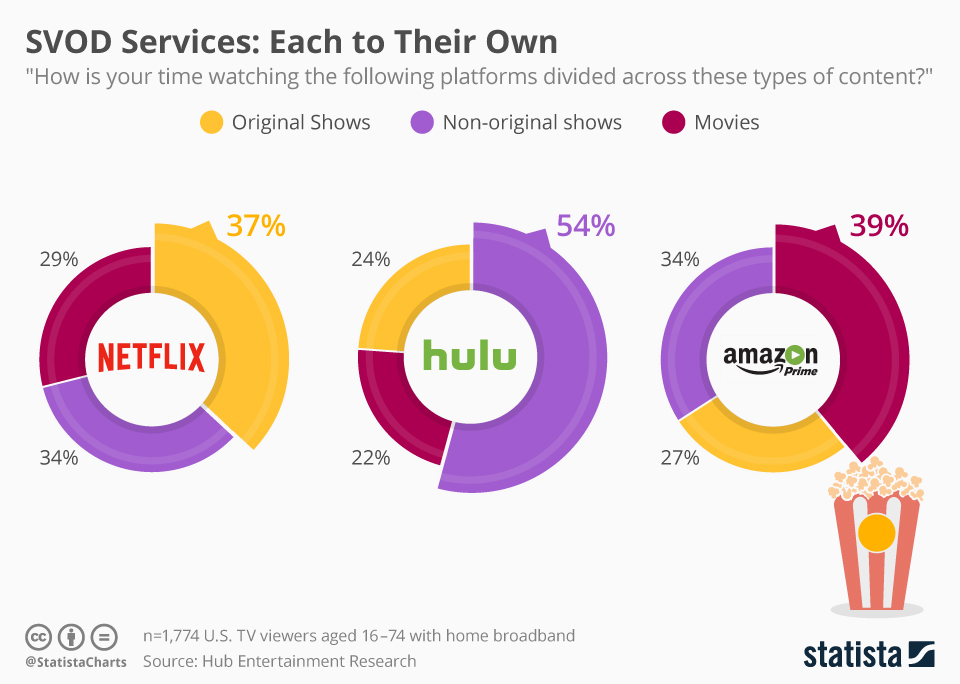Gone are the days where you needed to take a trip down to Blockbuster on a Friday night to be able to watch the newest movies or cry in distress when your favorite series ends. Now viewers can sit back and relax on their couch and watch all the latest releases and enjoy their favorite tv shows and movies without having to leave home.
History of Video Streaming Platforms
Back in 2005, a group of PayPal’s ex-employees founded a video streaming platform named YouTube. Within a short time, the unique platform started gaining popularity. Just a year after YouTube was launched, Google decided to acquire the company for $1.65 billion. Back then many people criticized the acquisition terming it an “Extravagant Purchase”. But this was an indicator that the industry will move fast towards streaming services and the growth will be spectacular. This inspired a company to scrap its idea of launching streaming devices and shift from being a DVD rental service to start an internet-based streaming service. The company we are talking about is Netflix.
Let’s travel back to 2006 when Amazon launched Amazon Unbox. Just one year after, Netflix launched a streaming service where people with an internet connection can watch shows online. Before Netflix or even YouTube came into the streaming platform scenario, China had already launched Youku and Todou, the platforms that are considered to be the original pioneers of video streaming. They were launched in 2003 and 2005, respectively. Baidu came into the scene shortly after and launched iQiyi in 2010. Now with all the major players that existed at the time, the services still struggled to generate revenue from the market. Fast forward to 2013, the recommendation system for these platforms developed to a great extent and the video streaming industry saw a major turn of events. Up until then, all the existing streaming platforms like Netflix, Amazon, and others focused almost all of their content budget in acquiring older TV shows and movies, which had already been released. Then in 2013, Netflix streamed its first original series ‘House of Cards’ and the power dynamics in the entertainment industry shifted. The popularity that came with the series proved that streaming services can come up with quality original content rather than streaming existing ones. After that Netflix continued to produce original TV shows including Orange is the New Black, Stranger Things, and Narcos that gained popularity worldwide. Following the trend, Amazon also produced some TV shows like The Man in The High Castle, Mr. Robot, etc. In order to enter the market, streaming services like Hulu also started producing their own shows.
Streaming & Cable Service
The invention of the television has been one of the most significant events of the 20th century considering both technological and entertainment aspects. To think it was possible to transmit video signals from one corner of the world to the other was only a dream. The journey of cable TV started with the idea of connecting more people with TV to avail improved services. In the early days of television broadcast, signals were transmitted using only the air transmission method. But this eventually became a problem for people who lived very far away from broadcast stations or lived in a high rise area such as the mountains. To address this problem, the practical approach was to introduce cable connection. Large antenna towers were built in those areas and hard wires were used to transmit the signals instead of air transmission. Those antennas were called “Community Antennas” and they were first introduced in 1948 in Arkansas, Oregon, and Pennsylvania, which was the beginning of the cable TV connection as we know it today. This launched us into a brand new era of technological advancement in the history of the entertainment industry.
When we look back in the history of TV entertainment, we can see many exciting stories and achievements that drove us to today’s modern age of entertainment. According to many experts, we are now entering the final era of cable services.
In the mid-2000s, television programs started to become available on the internet. This service was made possible due to two major technological breakthroughs called Discrete Cosine Transform (DCT) and Video Compression & Asymmetric Digital Subscriber Line (ADSL). Whereas DCT compressed the video to use a minimum amount of bandwidth for ease of transmission, ADSL increased the bandwidth of the data that could be transmitted. The combination of both made it possible for streaming services to be implemented and the world never looked back. What started out as an average streaming service and access to television programs, it soon took over our smart devices such as mobiles, tabs, TVs, etc. Apps for mobile devices started to become available in the Google Play Store around 2008. Shortly after in 2010, traditional cable & satellite television providers started to switch to streaming. DirectTV, which is a renowned satellite television provider, launched their own streaming service called DirectTV Now in 2016. Soon after Sky, a provider based in the UK launched Now TV, a similar streaming service. In 2017 YouTube launched YouTube TV which enabled its users to watch live television programs on the go, anytime, anywhere. This revolutionized the way people watched TV. People are now switching more and more to streaming services giving rise to ‘Cord Cutting’ trends. Accelerated by the Pandemic, major cable providers collectively lost around 7 million subscribers alone in 2020. Now, more and more people are dropping their cable connection to opt for streaming services. The charge for cable connections has not gone down much in the years of its existence. Compared to that, streaming services are providing more options and customizations at a much lower price.
The Rise and Prospects of OTT Platforms
OTT, short for “over-the-top,” is a media streaming service that serves as an alternative for traditional distribution methods such as satellite or cable television. With technological advancements and rapid upgrades to Wi-Fi networks, delivery of media is now more dependent on the internet. And the rise of OTT platforms had a revolutionary impact on how we view, create, distribute and even consume media content. Media consumption has visibly changed over the years with the introduction of over-the-top (OTT) media services and content which now clearly rules over mainstream media. Even a few years back televisions were the only source of video content. But with the advent of breakthrough technologies, everything about how we view media content is now changing.
Traditionally, video content was consumed by means of television where connectivity was provided using cable operators, or in more recent times, using set-top boxes. In this service, viewer’s choices were limited or somewhat controlled by third parties. Now if we go back to the 2000s, a remarkable improvement in data speeds and reduction of broadband costs led to an explosion of first-generation video streaming services and the world witnessed the arrival of ‘On-Demand’ services.
Now viewers can watch their favorite programs, any time they want, and for as many times as they wish. Another great thing about these services is that rather than waiting for your favorite show to come online, they could watch them at one go. From this, the concept of ‘Binge-Watching’ started to gain popularity. These services provided its users the flexibility and ‘ownership’ of the content they chose to watch. And this caused a change in consumer behavior. And this is where OTT platforms came to play a major role.
So, what do OTT platforms provide to their users? OTT platforms fall under a much larger segment called Video on Demand (VOD). These platforms can vary from subscription-based streaming services to custom-made proprietary solutions to fit the subscriber’s requirements. Whatever the method is, both provide some form of features that lets users choose their own content. You can watch them on the go as they are mostly cloud-based and most importantly, consumers know what they are paying for so they get their money’s worth.
Now besides these, there are many other factors that are driving the success of OTT Platforms that we see today. First of all, the OTT platform overcame the restriction and limitation of traditional media by providing a large database of video content to choose from, thus expanding viewer’s viewing choices and capabilities. These platforms are providing quality content and increased personalization as viewers can pick the shows that they want to watch. Another aspect that contributed to the wide growth of OTT platforms, is the revolution of the content consumption payment. The OTT platforms seem to offer content based on different regions. That means viewers get to enjoy both locally popular shows along with international ones. In the modern-day, a seamless payment method can be considered as critical as the quality of the content it provides. The smoother and easier the payment process, the higher the possibility of client acquisition and retention, which makes it possible for the service providers to utilize it well. To top it all off, a smoother transition into faster and more efficient mobile data and connectivity, where internet penetration has been phenomenal- the world is now witnessing transformational changes in the video streaming industries. From increasing availability to cheap mobile & internet services, to a boom in the number of smart devices sold around the world, the OTT platform is set to become a potential emerging market globally.
Worldwide Video Streaming Market Size & Rapid Growth
According to Statista, the global Video Streaming (SVoD) segment is projected to reach $71,237 million by the end of 2021. The revenue generation is expected to show an annual growth rate (CAGR 2021-2025) of 11.04%, resulting in a projected market value of $108,306 million by 2025. User penetration rate will be around 14.3% in 2021 and is expected to hit 18.2% by 2025. The average revenue per user (ARPU) is expected to amount to US$66.29. In global comparison, most revenue will be generated in the United States (US$32,082m in 2021). The top players who are dominating the market are Netflix, YouTube, Amazon Prime, and Hulu.

The USA has the highest SVoD revenue which amounts to approximately 30 million USD in 2020. And it will continue to lead in SVoD revenue as it is estimated to reach 42.06 million USD by 2025. Both the United States and China are expected to have a combined global market revenue of over 50% as the industry grows from 2020 to 2025.
If we specifically talk about the OTT market, it was valued at $101.42 Billion in 2020 and it is expected to reach $223.07 Billion by 2026, registering a CAGR of 13.87% during the period of 2021-2026.
Impacts of Global OTT Service Providers
The impact of global OTT services is quite evident as we shift from conventional media to OTT platforms. This can be factored by Customer Engagement (CE) and the Quality of Service (QoSE). Since OTT has more adaptability than conventional services, they can easily change their dynamics to fit customer’s behavior and emerging trends. It is reported that OTT services like YouTube, Netflix, and Spotify played a catalytic role to the growth of data streaming which caused a record growth of 140% rise in video streaming apps in Australia, India, Indonesia, South Korea, and Thailand. According to an article by deadline, nearly half of the households in the United States use not only one but multiple OTT streaming services. And this trend is spreading around the world as viewers require multiple OTT services to meet their needs. Statistics like that are proof of how Global OTT services are impacting digital platforms as a strong communication channel. This creates a huge impact on different industries such as telecom, entertainment, cable, digital media, advertising, and trends like ‘Cut The Cord’. Although OTT platforms or services do not directly affect operators or revenue generation of telecom sectors, they actively use their infrastructure to operate their services. But many operators themselves run services similar to OTT and it poses a threat to their own business. So the operators and OTT services providers are looking for ways to co-exist in the niche market. Globally the OTT video streaming service subscription has grown from 150 million in 2014 to 600 million in 2019 and it is expected to hit 1.1 billion by the end of 2021. On the other hand, traditional cable TV providers lost nearly 7 million subscribers alone in 2020. This shows a global shift from traditional viewing to on-the-go viewing or smart viewing. This is forcing the traditional providers to either switch to other businesses or adapt to this new wave of OTT content consumption-driven market, giving rise to the ‘Cord- Cutting’ trend. Recently the media houses are amplifying their growth by following OTT-based distribution models. Back in 2018, Netflix and Amazon alone spent about 40% of the total overall production budget of the entire world. In the last five years, the streaming industry has spent about $650 billion to create new content and acquire existing popular content. In fact, the OTT providers are now focusing their budget on original shows and production, which is taking a significant amount of their investment. Even back in 2018, about 37% of shows broadcast in Netflix were its original content, whereas for Amazon it was 39%.
The OTT dynamic is causing the film industry along with other relevant industries to rethink their approach and distribution. In fact, due to this change in the method of media consumption, the way we used to view advertisements has changed as well. Because of the dynamics of the OTT content distribution, advertisements are not static anymore, they have become more personalized, geographically appropriate, and targeted. Now advertisers can expand, customize, and pinpoint their targeted customer base which is expected to yield better results. It is predicted that OTT ads will increase about 35-60% in the near future.
Future of Streaming Industry
From the ever-changing, ever-emerging trends, fast growth, and fast pace to connectivity- it can be deduced that the landscape for the streaming industry is quite dynamic. They can be characterized by many drivers such as digitalization, new market offers, disruptive digital players, and so on. If we look back in 2018, streaming platforms like Netflix, Amazon Prime, Facebook Watch, and Sundance produced about 33% of the original shows that were broadcast worldwide followed by basic cable TV which held 30% of the share, and paid TV networks such as HBO consisted of only 9%. With new contenders entering the market daily, compact competition is resulting in more & more high-quality original content. It is anticipated by experts that in the coming future, we will see ‘small content offerings’ which will be more suited and tailored to an individual’s choice to enrich their viewing experience. The contents will be more customized to specific groups, their interest, culture, and language. The service or packages will be more granular in nature whilst the service charge will be more affordable than before. The services will offer more device-specific or operator-specific plans to penetrate more secluded populations. This will create opportunities for the OTT companies to develop partnerships with the operators and telecom companies. We are already seeing video plans for streaming sites like YouTube and Netflix. The day is not far away when customers will enjoy customized plans that suit their time, affordability, and preferences. Also with the advent of 5G technology, real-time streaming will tend to become more and more available. It is expected that 4k streaming solutions will also be available with 5G connectivity. That will make it possible to live stream programs and sports events, even 360-degree videos and VR reality content in high quality. Another aspect that we will see is the domination of connected TV (CTV) over regular TV. Now with growing subscribers and competition, the question of sustainability and revenue generations comes into the discussion. Due to growing competition, companies are often forced to lower their service charges but that hinders the sustainable revenue generation, ultimately threatening long-term sustainability. Many experts believe that OTT companies will have to come to a somewhat baseline pricing agreement rather than going for price and streaming wars, where the priority will be shifted towards content generation. The landscape of digital proliferation is ever-changing. So long as OTT platforms can adapt and change with the answers of ‘What’s New’ & ‘What comes next?’ they will continue to thrive.




